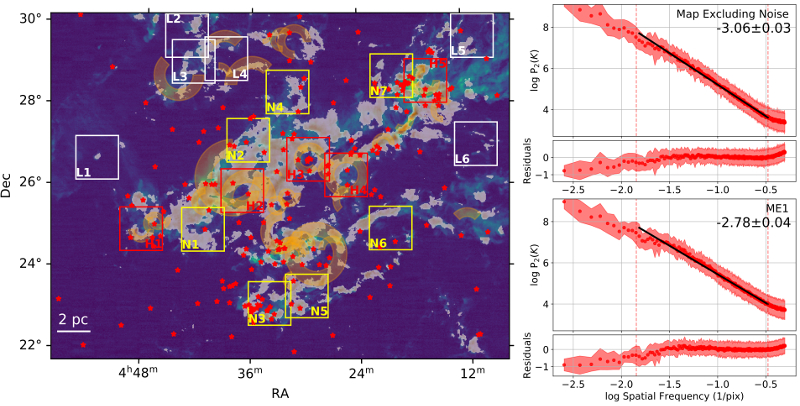| EPoS Contribution |
|
Properties of Feedback-Driven Bubbles in Nearby Molecular Clouds
Duo Xu UT Austin, Austin, US | |
| Stellar feedback created by radiation and winds from young stars plays a significant role in both the physical and chemical evolution of molecular clouds. This energy and momentum leaves an identifiable signature ("bubbles") that affects the dynamics and structure of the cloud. We adopt the deep learning method CASI-3D (Convolutional Approach to Shell Identification - 3D) to identify signatures of stellar feedback in molecular line spectra. We use magneto-hydrodynamics simulations modeling the impact of stellar winds in a turbulent molecular cloud to generate synthetic 12CO (J=1-0) and 13CO (J=1-0) observations. We train two CASI-3D models: ME1 predicts only the position of feedback, while MF predicts the fraction of the mass coming from feedback in each voxel. We apply the two CASI-3D models to the whole full Taurus and Perseus dataset. Based on the pixel level prediction of the feedback, we calculate the mass, momentum and energy of the feedback bubbles in both regions. Model MF demonstrates that feedback properties computed using visual identifications significantly over-estimate feedback impact due to line-of-sight confusion and contamination from background and foreground gas. This suggests that feedback is playing some role in driving turbulence but is not dominant. We find that feedback flattens the slope of the spatial power spectrum of the full 12CO and 13CO integrated intensity maps of Taurus and Perseus, indicating that mass and/or energy has been injected at smaller scales by feedback. We also find that feedback regions have larger velocity dispersions and the median value of the projected distance between the YSOs and the feedback gas is closer than that between the YSOs and all the emitting gas. | |
 | |
| Caption: Left: The 13CO integrated intensity of Taurus molecular cloud overlaid with the integrated prediction of feedback position from ME1 along velocity channels in red color. The arcs in yellow indicate the position of previously identified bubbles in Li et al. (2015). The star symbol demonstrates the location of the Class III YSOs from Kraus et al. (2017). Right: The spatial power spectrum (SPS) of the emission regions (excluding noise regions) of Taurus where the emission is above 0.2 K and the SPS of the ME1 predicted feedback regions. | |
| Collaborators: S., Offner, UT Austin, US R., Gutermuth, UMass Amherst, US C., Van Oort, UVM, US |
Key publication
Suggested Session: Turbulence |

